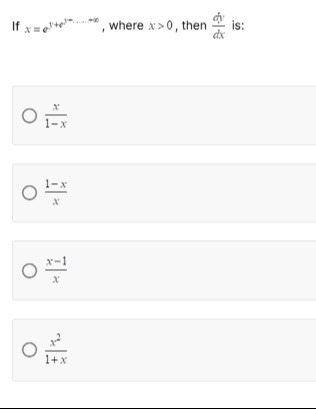Question
Question: If $x=e^{y+e^{y+e^{y+\cdots\infty}}}$, where $x>0$, then $\frac{dy}{dx}$ is:...
If x=ey+ey+ey+⋯∞, where x>0, then dxdy is:

1−xx
x1−x
xx−1
1+xx2
x1−x
Solution
The given equation is x=ey+ey+ey+⋯∞.
Observe the repeating pattern in the exponent. Let the entire expression on the right-hand side be x. The exponent part can be written as y+(ey+ey+⋯∞). The term in the parenthesis, ey+ey+⋯∞, is identical to the original expression x. Therefore, we can simplify the given equation as: x=ey+x
Now, we need to find dxdy. We can do this by first expressing y in terms of x, or by using implicit differentiation.
Method 1: Expressing y in terms of x Take the natural logarithm on both sides of the equation x=ey+x: ln(x)=ln(ey+x) Using the property ln(eA)=A: ln(x)=y+x
Now, isolate y: y=ln(x)−x
Differentiate y with respect to x: dxdy=dxd(ln(x)−x) Using the differentiation rules dxd(lnu)=u1 and dxd(x)=1: dxdy=x1−1
To combine the terms into a single fraction: dxdy=x1−xx dxdy=x1−x
Method 2: Implicit Differentiation Start with the simplified equation x=ey+x. Differentiate both sides with respect to x: dxd(x)=dxd(ey+x) 1=ey+x⋅dxd(y+x) (using the chain rule, where dud(eu)=eu and u=y+x) 1=ey+x⋅(dxdy+dxd(x)) 1=ey+x⋅(dxdy+1)
Now, substitute x back for ey+x (from the initial simplified equation): 1=x(dxdy+1)
Divide both sides by x: x1=dxdy+1
Isolate dxdy: dxdy=x1−1 dxdy=x1−x
Both methods yield the same result.
